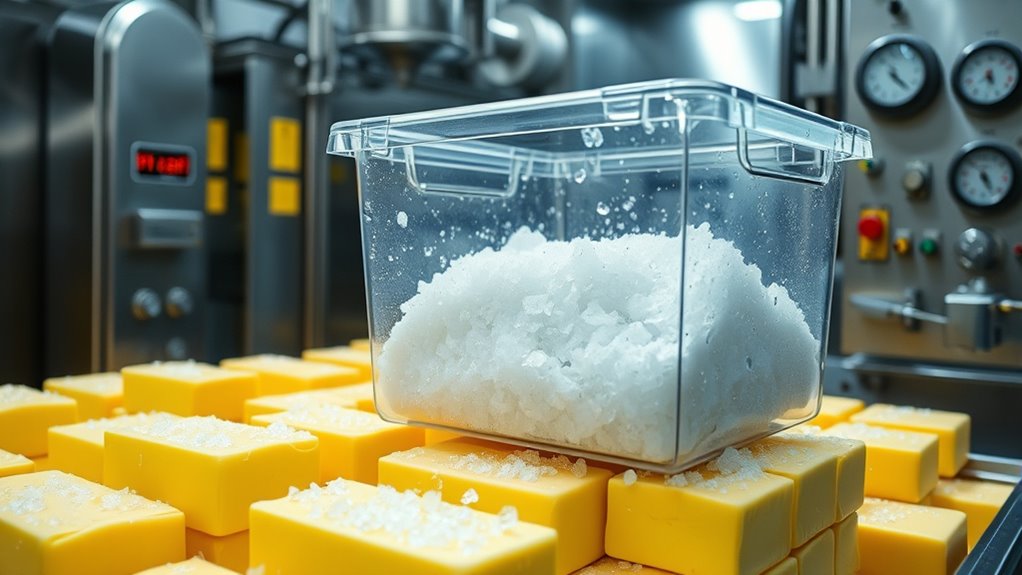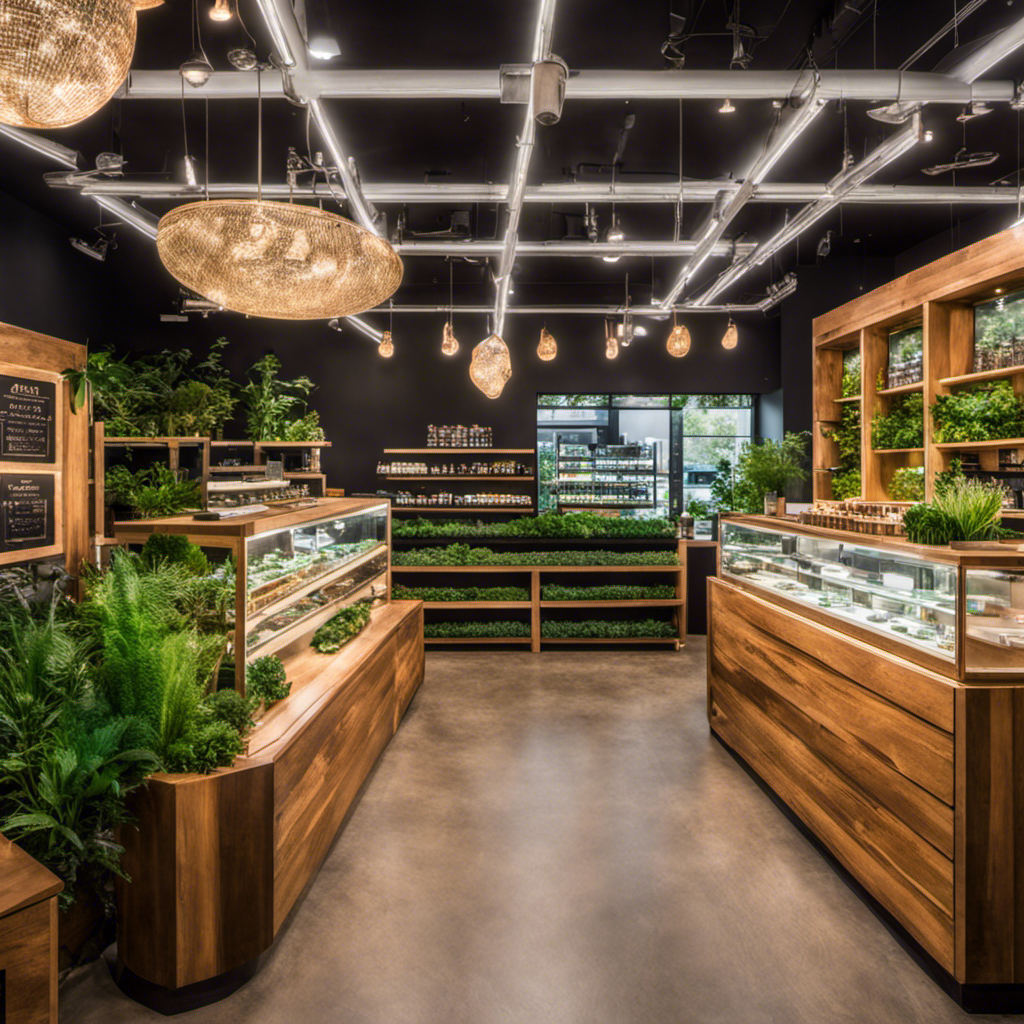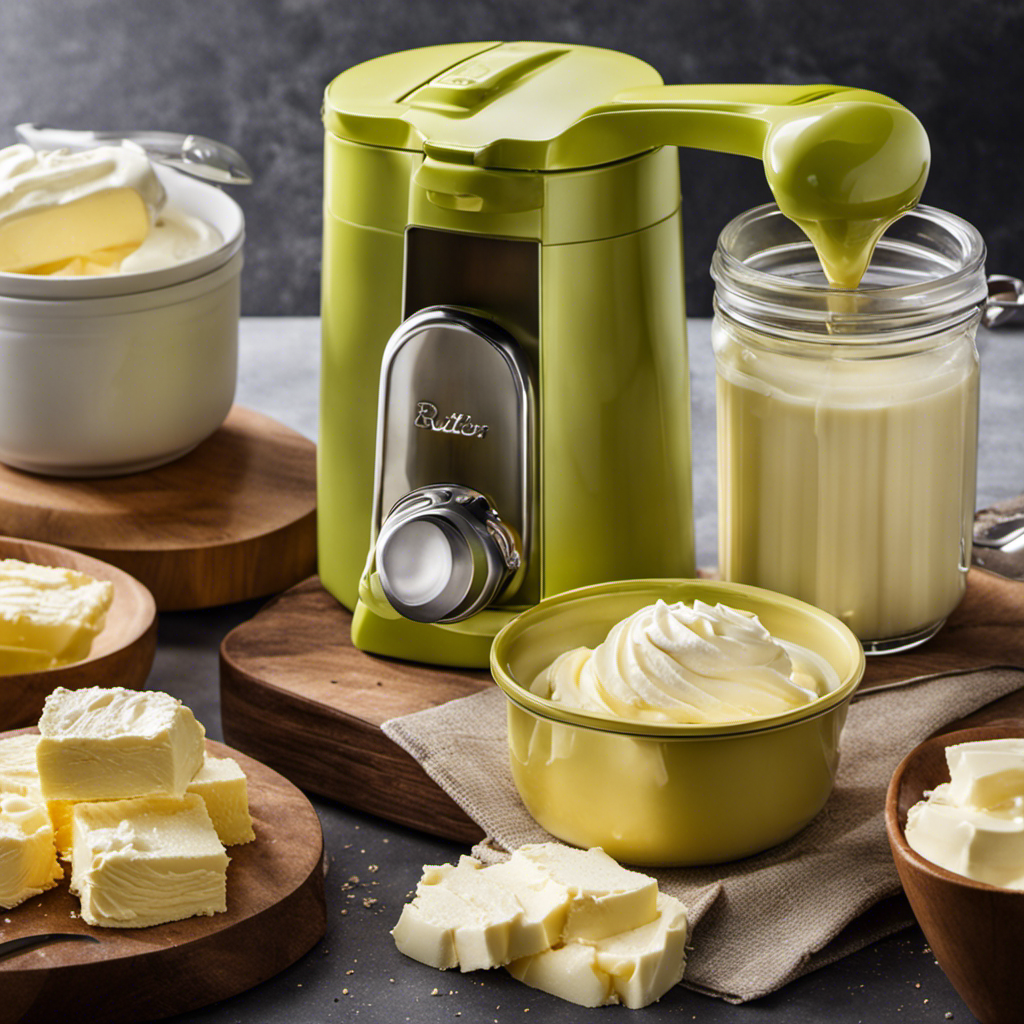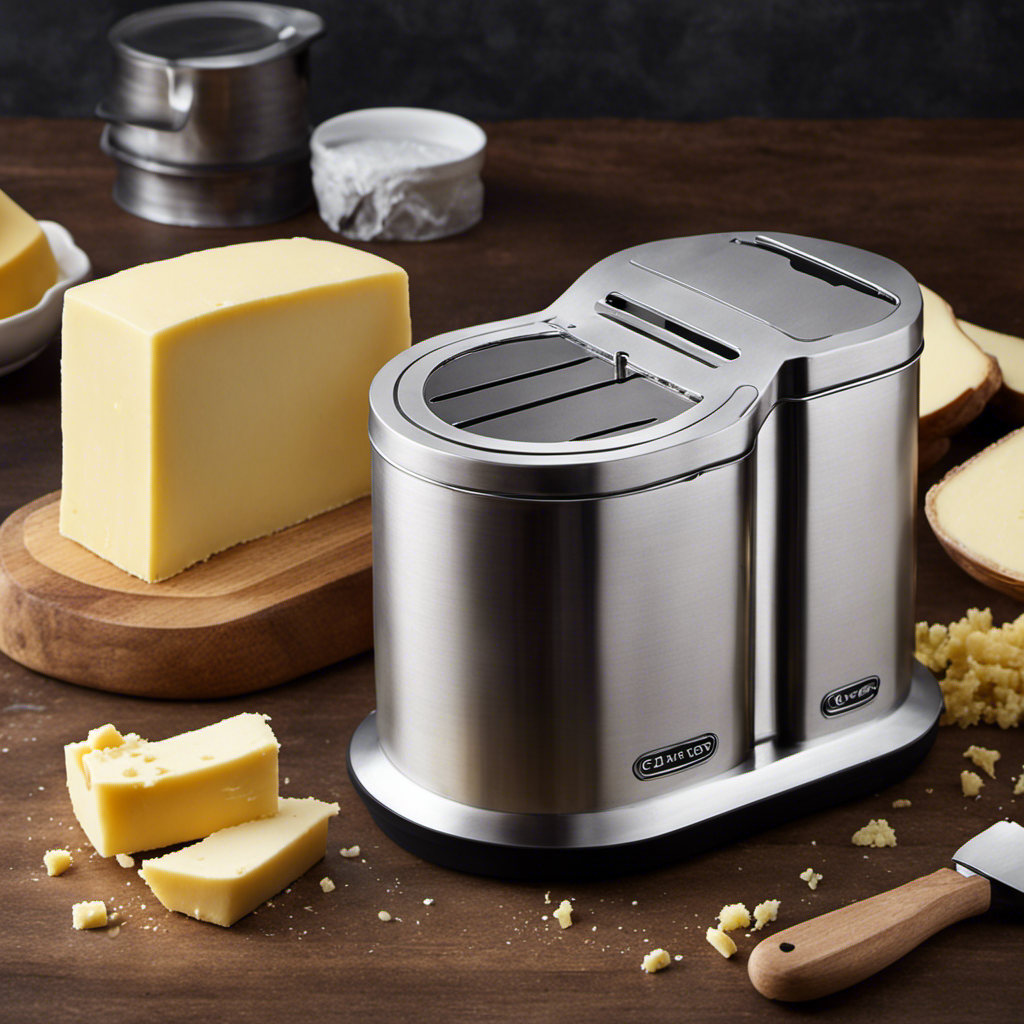Using CO₂ snow in butter logistics helps you maintain precise, consistent temperatures, preserving freshness and preventing spoilage. It’s eco-friendly, reduces energy use, and supports sustainability efforts. However, your safety precautions need to be solid, and you’ll have to guarantee compatibility with existing systems. While initial costs can be high, long-term savings and innovation opportunities make it worthwhile. Continue exploring to uncover more insights about optimizing this modern cooling method for your needs.
Key Takeaways
- CO₂ snow provides precise, rapid cooling that preserves butter quality and extends freshness during transportation.
- It reduces energy consumption compared to traditional refrigeration, lowering environmental impact and operational costs.
- Handling safety risks like frostbite and slippery surfaces require specialized training and equipment.
- Compatibility with existing logistics systems and regulatory compliance are essential for seamless integration.
- Future innovations in IoT and sustainable materials can enhance efficiency but may involve higher initial investments.
Enhanced Temperature Control and Preservation

CO₂ snow chilling offers superior temperature control that markedly benefits butter logistics. By maintaining consistent and precise temperatures, it guarantees ideal temperature stability throughout transportation and storage. This reliable cooling method prevents temperature fluctuations that can compromise butter’s quality. As a result, the product stays fresh longer, preserving its natural flavor and texture. The rapid cooling provided by CO₂ snow minimizes the risk of spoilage and microbial growth, which can occur if temperatures rise unexpectedly. This consistent environment reduces waste and guarantees that butter reaches consumers in prime condition. Whether shipping across short distances or long hauls, CO₂ snow chilling helps you maintain product freshness, giving you confidence that your butter remains high-quality from production to retail shelves. Additionally, understanding the importance of temperature management can further optimize storage and transportation processes, ensuring product integrity throughout the supply chain.
Environmental Impact and Sustainability Considerations

As you consider CO₂ snow chilling, it’s important to think about its environmental footprint. You’ll want to evaluate how it reduces carbon emissions, while also addressing energy use and waste management. Balancing these factors can help guarantee the process supports sustainability goals. Additionally, understanding the energy efficiency of the cooling method can influence its overall environmental impact.
Carbon Footprint Reduction
Implementing CO₂ snow chilling in butter logistics considerably cuts down the industry’s carbon footprint by replacing traditional refrigeration methods that rely on high energy consumption. Since CO₂ snow is a more environmentally friendly cooling method, it reduces reliance on electricity generated from fossil fuels. By utilizing renewable energy sources where possible, you further lower emissions associated with transportation and storage. Additionally, the process supports carbon offset initiatives, helping you balance out unavoidable emissions. This approach promotes sustainability by decreasing greenhouse gas emissions and fostering eco-conscious practices. As a result, your logistics operations become more environmentally responsible, aligning with global efforts to reduce climate impact. Furthermore, the use of energy-efficient cooling technologies ensures that operational costs are minimized while maintaining effective temperature control. Overall, CO₂ snow chilling offers a practical way to enhance sustainability in butter logistics while actively reducing your carbon footprint.
Energy Consumption Concerns
While CO₂ snow chilling reduces overall energy consumption compared to traditional refrigeration, it still requires energy input for its production and maintenance. This impacts energy efficiency and power requirements, raising concerns about sustainability. You should consider:
- The energy needed to generate the CO₂ snow, which can be substantial.
- The ongoing power demands to maintain ideal chilling conditions.
- Potential strain on energy grids, especially during peak times, increasing environmental impact.
- The importance of energy efficiency in minimizing environmental footprint and ensuring sustainable operations.
Although it offers a greener alternative, its power requirements mean you must weigh the environmental benefits against the energy costs. If not managed properly, increased energy use could offset the positive effects on carbon footprint reduction. Remember, sustainable practices depend on maximizing energy efficiency at every step.
Recycling and Disposal
Recycling and disposal of CO₂ snow are critical to minimizing environmental impacts and ensuring sustainability. Proper management prevents unnecessary greenhouse gas release and reduces ecological harm. When disposing of CO₂ snow, you should consider alternative disposal methods that avoid contributing to atmospheric pollution. Additionally, integrating biodegradable packaging can help lessen waste and promote eco-friendly practices. Recycling CO₂ snow involves capturing and reusing it within the logistics system, decreasing the need for new CO₂ production. If disposal is necessary, choose options like venting in controlled environments or converting CO₂ into useful products. Implementing sound design techniques can facilitate better communication of environmental practices through clear audio cues and informational content. By prioritizing responsible disposal and recycling, you support greener logistics operations and reduce your carbon footprint. These steps help ensure that butter logistics remain environmentally sustainable over the long term.
Cost Implications and Economic Feasibility

Although CO₂ snow chilling offers environmental benefits, its cost implications and economic feasibility remain significant considerations for butter logistics. A detailed cost analysis reveals that initial investment costs for specialized equipment can be substantial, making it a major hurdle. Here are three key points to contemplate:
- The upfront expenses may strain budgets, especially for smaller producers.
- Ongoing operational costs, including maintenance and CO₂ supply, can add up quickly.
- Long-term savings in energy and reduced waste might offset initial costs, but only if volume and efficiency are optimized.
- Understanding the cost structure involved in CO₂ snow chilling is crucial for making informed investment decisions.
While the environmental gains are clear, you need to evaluate whether the potential cost savings and increased product quality justify the investment. Careful financial planning is essential before adopting this method.
Safety and Handling Challenges

Handling CO₂ snow in butter logistics presents notable safety challenges that cannot be overlooked. You must prioritize chemical safety to prevent accidents, as improperly handled CO₂ can cause frostbite or asphyxiation. Proper staff training is essential to guarantee safe handling, storage, and transport. Without it, risks increase considerably. To help, consider this table:
| Safety Risk | Cause | Prevention |
|---|---|---|
| Frostbite burns | Direct contact with snow | Use protective gloves and gear |
| Asphyxiation risk | CO₂ displaces oxygen | Ensure proper ventilation |
| Slippery surfaces | CO₂ condensates | Regular clean-up and signage |
Additionally, understanding the properties of organic and natural juices can aid in developing safer handling protocols for CO₂ snow.
Compatibility With Existing Logistics Infrastructure

Integrating CO₂ snow chilling into existing butter logistics systems requires careful assessment of current infrastructure. You’ll need to evaluate if your equipment can handle the new cooling method and what modifications are essential. Proper equipment integration ensures smooth operation and avoids costly delays. Staff training becomes critical; your team must understand how to operate new chilling systems safely and efficiently. Consider these key points:
- Will your current cooling and storage units support CO₂ snow systems without extensive upgrades?
- Are your staff prepared to adapt to new handling procedures and safety protocols?
- How seamlessly can you coordinate equipment updates with ongoing logistics processes? Butter’s artistic significance and cultural symbolism can also influence how you approach these upgrades to maintain quality and presentation standards.
Addressing these factors early helps minimize disruptions, ensuring that your butter remains fresh and your logistics stay efficient.
Quality Maintenance and Product Integrity

Maintaining product quality is vital when implementing CO₂ snow chilling in butter logistics, as the rapid cooling process can considerably impact freshness and texture. To preserve butter’s ideal qualities, you need to guarantee odor control, preventing any unwanted smells from affecting the product. Proper handling minimizes contamination and keeps the butter tasting fresh. Additionally, equipment durability plays a key role; reliable, sturdy machinery maintains consistent cooling without breakdowns that could compromise product integrity. Regular maintenance prevents temperature fluctuations that might cause butter to spoil or develop off-flavors. By focusing on odor control and investing in durable equipment, you safeguard the butter’s quality during chilling, ensuring it arrives in perfect condition and meets consumer expectations for freshness and texture. Incorporating dog breeds knowledge can also help in understanding the importance of tailored handling techniques to maintain product integrity.
Regulatory Compliance and Industry Standards

Ensuring regulatory compliance and adhering to industry standards are essential when implementing CO₂ snow chilling in butter logistics. Failure to do so can expose you to serious liability issues and legal penalties. You must prioritize:
- Meeting labeling requirements to clearly communicate the chilling process and safety information, safeguarding consumer trust.
- Following safety regulations that protect workers and prevent accidents related to CO₂ handling.
- Ensuring proper documentation to demonstrate compliance during inspections, avoiding costly fines or product recalls.
- Using specialized equipment designed for CO₂ applications to ensure safety and efficiency during the chilling process.
Neglecting these standards can damage your reputation and incur severe legal consequences. Staying proactive with regulatory adherence not only minimizes liability issues but also ensures your butter remains safe and compliant in a competitive market.
Scalability and Operational Flexibility

As your butter logistics operations grow, the ability to scale CO₂ snow chilling processes and adapt to changing demand becomes essential. Scalability challenges may arise as you try to expand cooling capacity without disrupting existing workflows. You’ll need equipment that can handle increased throughput and maintain consistent quality, which isn’t always straightforward with CO₂ snow systems. Operational flexibility is also critical; you should be able to adjust chilling rates quickly based on demand fluctuations. However, integrating new systems or expanding current setups can require significant planning, investment, and training. While CO₂ snow chilling offers precise temperature control, its scalability depends on your infrastructure’s ability to support larger or more flexible operations. Overcoming these challenges ensures your butter stays fresh and meets market demands efficiently.
Potential for Innovation and Future Developments

The potential for innovation in CO₂ snow chilling technology opens exciting opportunities for the future of butter logistics. Advancements in technological breakthroughs could revolutionize how you preserve product quality while reducing costs. As market adoption grows, you’ll see more efficient systems that lower energy consumption and emissions.
Innovations in CO₂ snow chilling promise more sustainable, cost-effective butter logistics with smarter controls and IoT integration.
Here are three promising developments:
- Enhanced cooling efficiency through smarter, automated controls.
- Novel materials that improve CO₂ snow production and storage.
- Integration with IoT for real-time monitoring and optimized logistics.
These innovations could make CO₂ snow chilling more accessible and sustainable, giving you a competitive edge. Staying ahead means embracing these future developments and contributing to a greener, more resilient supply chain.
Frequently Asked Questions
How Does Co₂ Snow Compare to Traditional Cooling Methods in Efficiency?
When comparing CO₂ snow to traditional cooling methods, you’ll find that CO₂ snow offers higher energy efficiency because it requires less power to maintain low temperatures. Additionally, the cost comparison often favors CO₂ snow, as it reduces operational expenses through quicker cooling times and less energy consumption. This makes it a more sustainable and cost-effective option for chilling processes, especially when rapid cooling is essential.
What Are the Long-Term Environmental Benefits of Using Co₂ Snow?
Did you know that using CO₂ snow can reduce the carbon footprint of cold logistics by up to 30%? Long-term, this method supports environmental sustainability by lowering greenhouse gas emissions. Plus, it aligns with renewable energy efforts, as CO₂ can be captured from industrial processes. By choosing CO₂ snow, you help reduce reliance on fossil fuels, contributing to a healthier planet and a more sustainable future.
Are There Specific Types of Butter That Benefit Most From Co₂ Snow Chilling?
You’ll find that butter with delicate texture or subtle flavor benefits most from CO₂ snow chilling. This method helps preserve butter’s smoothness and enhances flavor retention by cooling it quickly and uniformly. If you’re working with high-quality or artisan butters, CO₂ snow chilling ensures you maintain the desired butter texture and flavor profile, making it ideal for products that require ideal freshness and quality during storage and transportation.
How Does Co₂ Snow Affect the Shelf Life of Butter Products?
You’ll find that CO₂ snow helps extend butter’s shelf life by keeping moisture retention high and microbial growth low. It rapidly cools the product, reducing temperature fluctuations that can promote spoilage. This chilling method preserves butter’s quality longer, maintains its freshness, and minimizes microbial activity. As a result, your butter stays fresher, safer, and better tasting for an extended period, making CO₂ snow a valuable tool in butter storage and transportation.
What Training Is Required for Staff Handling Co₂ Snow in Logistics?
Did you know that improper handling of CO₂ snow can cause frostbite or suffocation? As someone working in logistics, you need specialized training on hazard management and safety protocols. You’ll learn how to recognize risks, use protective gear correctly, and handle CO₂ snow securely. This training ensures you stay safe and compliant, minimizing accidents and environmental hazards during transportation and storage.
Conclusion
Embracing CO₂ snow chilling in butter logistics could revolutionize your cold chain—imagine flawless preservation, unbeatable efficiency, and eco-friendly bragging rights all in one! Sure, there are hurdles like safety and costs, but the potential to elevate quality, streamline operations, and lead industry innovation is mind-blowing. Don’t just keep up—leap ahead and harness this game-changing technology to transform your butter logistics into a marvel of modern refrigeration. The future’s waiting—are you ready to seize it?










